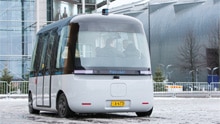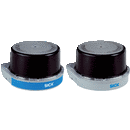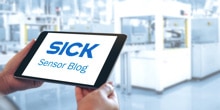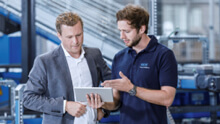为确保植物以理想的状态生长,在苗圃或园艺中心,重达 10 kg 的盆栽需要每天定期移动和重新摆放。这是一项艰巨而费力的工作。颇具远见的法国 Instar Robotics 公司的 Pierre Delarboulas 和 Adrien Jauffret 为此带来了转机。他们的自主机器人“Trooper”负责搬运盆栽,为园艺行业的自动化做出了贡献。3D 激光雷达 MRS1000 能够在恶劣环境中确保准确导航和环境监测。
超级 Trooper:自主机器人帮助园艺师搬运盆栽
Instar Robotics 是一家年轻的初创公司,由 Pierre Delarboulas 和 Adrien Jauffret 于 2018 年创立。两位科学工作者均拥有人工智能和机器人技术的博士学位,并且很久以前就对机器人技术产生了兴趣。他们的理想是:让实用的机器人技术为人们的日常生活提供支持,让人们重新专注于自己的职业。
帮助苗圃搬运盆栽
公司创始人从小就有从事农业工作的愿望。该行业尤其给机器人技术带来了众多技术挑战。户外应用的条件丰富多样,而且不断变化(环境、天气、土壤...)。因此,必须开发出适应性强、灵活可靠的机器人。
经过广泛的研究,两位科学家发现园艺行业和盆栽搬运是一项以人工为主、重复性强、体力消耗大的工作。此外,这些工作通常由季节工完成,由于条件艰苦,这些工人越来越难找。因此,所有先决条件均已具备,可以开发一种能够减轻工人劳动强度的机器人解决方案。
苗圃中有两项工作对植物的品质尤为重要:将植物摆放得更近或更远。前者适用于种植初期,目的是优化可用空间。在准备阶段和上盆期间,要将花盆“呈长方形”彼此相邻地“放在大厅地板上”,以促进最初的生长阶段。一段时间后,这些花盆会被单独运到苗圃的不同位置。这样既能让植物茁壮成长,又能防止疾病传播。有些苗圃占地数百公顷,要运送 10 万多个最重可达 10 kg 的花盆。可想而知,这种高度重复性的工作将从自动化解决方案中受益匪浅。
开发搬运机器人,减轻苗圃工作量
因此,很有必要开发一种小型自主机器人来帮助园艺师和苗圃公司将花盆从公司内部的 A 处运送到 B 处,以及将它们靠近或分开——Trooper 由此诞生。
环境感知是最早出现的问题之一。机器人必须能够:
- 自主移动、
- 感知周围环境、
- 识别障碍物、
- 识别花盆、
- 正确定位以抓取花盆、
- 确定方向、
- 并且以安全的方式与人类合作完成所有这些工作。
因此,3D 激光雷达成为理想之选——最终,Instar Robotics 选择了多层扫描激光雷达 MRS1000。
用于环境感知的 Trooper“眼睛”
MRS1000 是一种多层扫描激光雷达,Pierre Delarboulas 将其形容为“Trooper 的眼睛”。它能生成点云,提供与物体之间的距离用于计算路线,还可以建立形状模型以重建物体。Instar Robotics 公司开发的算法通过搜索由点云和激光雷达四个扫描层重建的圆(即花盆)来识别物体。
传感器还能直接确定物体的反射,以便根据物体的颜色进行更好的区分。这就提高了机器人的反应灵活性:它能做出更好的决策,并与环境进行适当的互动。
3D 激光雷达的出色性能带来巨大成功
MRS1000 的性能是项目成功的关键因素之一。它可以在 275° 的视野范围内探测和测量物体。通过在四个不同的平面上同时进行测量,MRS1000 能够对物体进行详细检测并跟踪其移动方向。坚固耐用的外壳防尘、耐热、防潮。得益于 HDDM+ 技术,即使在雾天或强光下也特别可靠和高效,满足 Instar Robotics 的所有要求。
为苗圃节省 15% 的空间
Pierre Delarboulas 说:“园艺师们一致认为,Trooper 到来之前和到来之后的变化可谓翻天覆地。”行业的劳动力短缺问题十分突出,主要原因是需要频繁调整盆栽距离所带来的繁重工作。机器人使员工们可以从这项工作中解脱出来,有更多的时间和精力投入到其他要求更高、更有动力的工作中去。
项目在效率方面的表现也非常出色。机器人永不疲倦,在任何天气条件下都能工作,并能将花盆放置在理想的位置。这为苗圃节省了 15% 的操作空间。
根据机器的使用情况,投资一台机器人大约需要四到五年就能收回成本。对于农业领域的投资来说,这是一个相对较短的时间。
“始终有人为我们提供支持”

这是 Pierre Delarboulas 对法国 SICK 各个团队的评价。Trooper 是与 SICK 共同设计并不断改进的。例如,由于传感器在机器人上的位置,最初非常容易受到外部条件(雨水、泥土)的影响。因此必须使用定制的防护罩对其进行遮蔽。经过 SICK 团队的研究,设计出了更紧凑的保护装置,以实现更好的性能。双方对于此次合作都非常满意。
前景如何?
新产品前景广阔。目前正在开发三种新工具,以扩充 Trooper 的功能,解决园艺行业劳动力短缺的问题:
- 切割和修剪植物
- 用胶带包裹植物进行害虫防治
- 土壤处理,例如在花盆中的植物周围均匀施肥
更多文章











